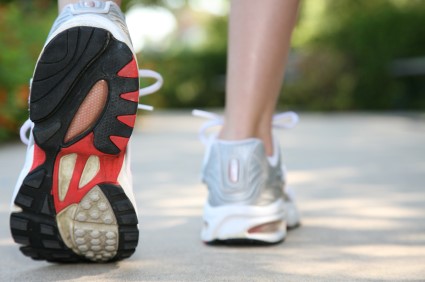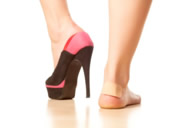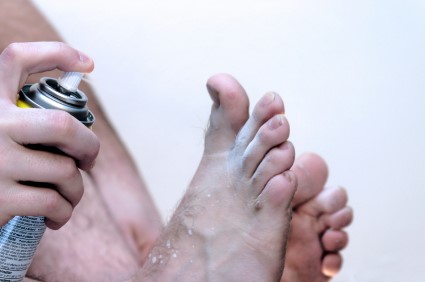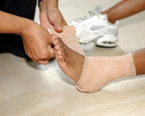Connect With Us
Items filtered by date: May 2016
Take Proper Preventative Care to Reduce Risk of Running Injuries
 As running and jogging are becoming more common activities as the weather is getting warmer, it’s important to know how to reduce the risk of injury as we exercise. “It’s estimated that at least 40-50 percent of runners will experience some type of injury in a given year.” As running is a repetitive motion, this can lead to constant pressure on our legs and feet and eventually overuse injuries. To avoid the risk of running injuries, stretching, training, having the proper footwear, and keeping in mind your own personal biomechanics are all important aspects to consider.
As running and jogging are becoming more common activities as the weather is getting warmer, it’s important to know how to reduce the risk of injury as we exercise. “It’s estimated that at least 40-50 percent of runners will experience some type of injury in a given year.” As running is a repetitive motion, this can lead to constant pressure on our legs and feet and eventually overuse injuries. To avoid the risk of running injuries, stretching, training, having the proper footwear, and keeping in mind your own personal biomechanics are all important aspects to consider.
Runners can still be prone to running injuries even with proper precautions. If you are suffering from a running injury, visit one of our podiatrists of The Podiatry Center, P.C.. Our doctors will assess your injury and provide you with quality treatment.
How to Prevent Running Injuries
Many common running injuries are caused by overuse and overtraining. When the back of the kneecap starts wearing out and starts causing pain in your knee, this is commonly referred to as runner’s knee. Runner’s knee is a decrease in strength in your quadriceps and can occur if you’re not wearing properly fitted or supporting shoes. To prevent runner’s knee, focusing on hip strengthening is a good idea, as well as strengthening your quads to keep the kneecaps aligned.
What Are Some Causes of Running Injuries?
- One cause of a common running injury is called iliotibial band syndrome.
- Plantar fasciitis is also another common injury.
- Stress fractures can occur from overtraining, lack of calcium, or even your running style.
Best Ways to Prevent Running Injuries
- Wear footwear that fits properly and suits your running needs.
- Running shoes are the only protective gear that runners have to safeguard them from injury.
- Make a training schedule. Adding strengthening exercises as well as regular stretching can help keep you strong and limber and can lessen the possibility of injuries.
- Stretching keeps muscles limber, this will help you gain better flexibility.
If you have any questions, please feel free to contact our office located in Millburn, NJ. We offer the newest diagnostic tools and technologies to treat your foot and ankle needs.
Various Complications Arise from Habitual High Heel Wear
 High heels are extremely damaging as they alter your body’s posture, lead to back pain, change your natural gait, and can cause several other complications if worn for long periods of time. Other consequences include ankle instability, unstable biomechanics in the feet, and uneven pressure being exerted on the feet and the ball of each foot as we walk or run. The narrowness of high heels can also lead to bunions forming as our toes are pressed together unnaturally. It’s recommended to wear high heels in moderation or to avoid them altogether.
High heels are extremely damaging as they alter your body’s posture, lead to back pain, change your natural gait, and can cause several other complications if worn for long periods of time. Other consequences include ankle instability, unstable biomechanics in the feet, and uneven pressure being exerted on the feet and the ball of each foot as we walk or run. The narrowness of high heels can also lead to bunions forming as our toes are pressed together unnaturally. It’s recommended to wear high heels in moderation or to avoid them altogether.
High heels have a history for causing foot and ankle problems. If you have any concerns about your feet visit one of our podiatrists of The Podiatry Center, P.C.. Our doctors will assess your injury and provide you with quality treatment.
Effects of High Heels on the Feet
High heels are popular shoes among women because their style and societal appeal. Despite this, they can still cause many health problems if worn too frequently.
What parts my body will be affected by high heels?
- Ankle Joints
- Achilles Tendon – may shorten and stiffen with prolonged wear
- Balls of the Feet
- Knees – heels cause the knees to bend constantly, creating stress on them
- Back – they decrease the spine’s ability to absorb shock, which may lead to back pain. Also, the vertebrae of the lower back may compress.
What kinds of foot problems can develop from wearing high heels?
- Corns
- Calluses
- Hammertoe
- Bunions
- Morton’s Neuroma
- Plantar Fasciitis
How can I still wear high heels and maintain foot health?
If you want to wear high heeled shoes, make sure that you are not wearing them every day, as this will help prevent long term physical problems. Try wearing thicker heels as opposed to stilettos to distribute weight more evenly across the feet. Always make sure you are wearing the proper shoes for the right occasion, such as sneakers for exercising. If you walk to work, try carrying your heels with you and changing into them once you arrive at work. Adding inserts to your heels can help cushion your feet and absorb shock. Full foot inserts or metatarsal pads are available.
If you have any questions, please feel free to contact our office located in Millburn, NJ. We offer the newest diagnostic tools and technologies to treat your foot and ankle needs.
Axl Rose Fractures Metatarsal in Foot
 Axl Rose, frontman for the popular band Guns N’ Roses, performed at Coachella with a broken foot. According to his foot and ankle specialist, Rose had fractured the fifth metatarsal in his foot. He had surgery which involved doctors inserting a plate and screws to hold up his bones, which had been realigned. As Rose is recovering, he had to avoid putting too much weight on his healing foot.
Axl Rose, frontman for the popular band Guns N’ Roses, performed at Coachella with a broken foot. According to his foot and ankle specialist, Rose had fractured the fifth metatarsal in his foot. He had surgery which involved doctors inserting a plate and screws to hold up his bones, which had been realigned. As Rose is recovering, he had to avoid putting too much weight on his healing foot.
A broken foot requires immediate medical attention and treatment. To learn more, visit one of our podiatrists of The Podiatry Center, P.C.. Our doctors will assess your injury and provide you with quality treatment.
Broken Foot Causes, Symptoms, and Treatment
A broken foot is caused by one of the bones in the foot typically breaking when bended, crushed, or stretched beyond its natural capabilities. Usually the location of the fracture indicates how the break occurred, whether it was through an object, fall, or any other type of injury.
Common Symptoms of Broken Feet:
- Bruising
- Pain
- Redness
- Swelling
- Blue (foot)
- Numbness
- Cold
- Misshapen
- Cuts
- Deformities
Those that suspect they have a broken foot shoot seek urgent medical attention where a medical professional could diagnose the severity.
Treatment for broken bones varies depending on the cause, severity and location. Some will require the use of splints, casts or crutches while others could even involve surgery to repair the broken bones. Personal care includes the use of ice and keeping the foot stabilized and elevated.
If you have any questions, please feel free to contact our office located in Millburn, NJ. We offer the newest diagnostic tools and technologies to treat your foot and ankle needs.
Understanding Athlete’s Foot
 Keeping your shoes and feet clean are important in protecting against foot infections such as athlete’s foot. Athlete’s foot, caused by fungus, can accumulate and thrive on our skin when we sweat. It’s essential to change your socks often and to invest in antifungal treatments to kill bacteria. Over-the-counter treatment options for athlete’s foot include antifungal ointment or shoe spray.
Keeping your shoes and feet clean are important in protecting against foot infections such as athlete’s foot. Athlete’s foot, caused by fungus, can accumulate and thrive on our skin when we sweat. It’s essential to change your socks often and to invest in antifungal treatments to kill bacteria. Over-the-counter treatment options for athlete’s foot include antifungal ointment or shoe spray.
Athlete’s foot is an inconvenient condition that can be easily reduced with the proper treatment. If you have any concerns about your feet and ankles visit one of our podiatrists of The Podiatry Center, P.C.. Our doctors will assess your injury and provide you with quality treatment.
Athlete’s Foot: The Sole Story
Athlete's foot, also known as tinea pedis, can be an extremely contagious foot infection. It is commonly contracted in public changing areas and bathrooms, dormitory style living quarters, around locker rooms and public swimming pools, or anywhere your feet often come into contact with other people.
Solutions to Combat Athlete’s Foot
- Hydrate your feet by using lotion
- Exfoliate
- Buff off nails
- Use of anti-fungal products
- Examine your feet and visit your doctor if any suspicious blisters or cuts develop
Athlete’s foot can cause many irritating symptoms such as dry and flaking skin, itching, and redness. Some more severe symptoms can include bleeding and cracked skin, intense itching and burning and even pain when walking. In the worst cases, athlete’s foot can cause blistering as well. Speak to your podiatrist for a better understanding of the different causes of athlete’s foot, as well as helping you figure out which treatment options are best for you.
If you have any questions, please feel free to contact our office located in Millburn, NJ. We offer the newest diagnostic tools and technologies to treat your foot and ankle needs.
Gordon Hayward out due to Foot Injury
 Gordon Hayward of the Utah Jazz did not play against the Cleveland Cavaliers because of plantar fasciitis he was suffering from in his right foot. His status at the time was considered day-to-day. Hayward leads the team with “averages of 20.1 points, 3.7 assists and 36.2 minutes per game. He also averages 4.9 rebounds per game.” The Jazz team also suffered losses with players Rudy Gobert, Derrick Favors, Alec Burks, and Dante Exum out.
Gordon Hayward of the Utah Jazz did not play against the Cleveland Cavaliers because of plantar fasciitis he was suffering from in his right foot. His status at the time was considered day-to-day. Hayward leads the team with “averages of 20.1 points, 3.7 assists and 36.2 minutes per game. He also averages 4.9 rebounds per game.” The Jazz team also suffered losses with players Rudy Gobert, Derrick Favors, Alec Burks, and Dante Exum out.
Sports related foot and ankle injuries need proper treatment before players can go back to their regular routines. If you have any concerns, visit one of our podiatrists of The Podiatry Center, P.C.. Our doctors will assess your injury and provide you with quality treatment.
Sport Related Foot and Ankle Injuries
Foot and ankle injuries are a common occurrence when it comes to athletes of any sport. While many athletes dismiss the initial aches and pains, the truth is that ignoring potential foot and ankle injuries can lead to serious problems. As athletes continue to place pressure and strain the area further, a mild injury can turn into something as serious as a rupture and may lead to a permanent disability. There are many factors that contribute to sports related foot and ankle injuries, which include failure to warm up properly, not providing support or wearing bad footwear. Common injuries and conditions athletes face, including:
- Plantar Fasciitis
- Plantar Fasciosis
- Achilles Tendinitis
- Achilles Tendon Rupture
- Ankle Sprains
Sports-related injuries are commonly treated using the RICE method. This includes rest, applying ice to the injured area, compression and elevating the ankle. More serious sprains and injuries may require surgery, which could include arthroscopic and reconstructive surgery. Rehabilitation and therapy may also be required in order to get any recovering athlete to become fully functional again. Any unusual aches and pains an athlete sustains must be evaluated by a licensed, reputable medical professional.
If you have any questions, please feel free to contact our office located in Millburn, NJ. We offer the newest diagnostic tools and technologies to treat your foot and ankle needs.
Blog Archives
- June 2025
- May 2025
- April 2025
- March 2025
- February 2025
- January 2025
- December 2024
- November 2024
- October 2024
- September 2024
- August 2024
- July 2024
- June 2024
- May 2024
- April 2024
- March 2024
- February 2024
- January 2024
- December 2023
- November 2023
- October 2023
- September 2023
- August 2023
- July 2023
- June 2023
- May 2023
- April 2023
- March 2023
- February 2023
- January 2023
- December 2022
- November 2022
- October 2022
- September 2022
- August 2022
- July 2022
- June 2022
- May 2022
- April 2022
- March 2022
- February 2022
- January 2022
- December 2021
- November 2021
- October 2021
- September 2021
- August 2021
- July 2021
- June 2021
- May 2021
- April 2021
- March 2021
- February 2021
- January 2021
- December 2020
- November 2020
- October 2020
- September 2020
- August 2020
- July 2020
- June 2020
- May 2020
- April 2020
- March 2020
- February 2020
- January 2020
- December 2019
- November 2019
- October 2019
- September 2019
- August 2019
- July 2019
- June 2019
- May 2019
- April 2019
- March 2019
- February 2019
- January 2019
- December 2018
- November 2018
- October 2018
- September 2018
- August 2018
- July 2018
- June 2018
- May 2018
- April 2018
- March 2018
- February 2018
- January 2018
- December 2017
- November 2017
- October 2017
- September 2017
- August 2017
- July 2017
- June 2017
- May 2017
- April 2017
- March 2017
- February 2017
- January 2017
- December 2016
- November 2016
- October 2016
- September 2016
- August 2016
- July 2016
- June 2016
- May 2016
- April 2016
- March 2016
- February 2016
- January 2016
- December 2015
- November 2015
- October 2015
- September 2015
- August 2015
- July 2015
- June 2015
- May 2015
- January 2014
- December 2013
- November 2013
- October 2013
- September 2013
- August 2013
- July 2013
- June 2013
- May 2013
- April 2013
- March 2013
- February 2013
- January 2013
- December 2012
- November 2012
- October 2012
- September 2012
- August 2012
- July 2012
- June 2012
